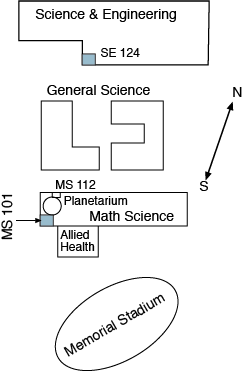 |
Nick StrobelProfessor, |
| Personal Information | Contact Information | Current Classes | Author | BC Homepage |
 |
Nick StrobelProfessor, |
| Personal Information | Contact Information | Current Classes | Author | BC Homepage |
| BS -- Astronomy and Physics (double major) -- University of Arizona 1987 |
| MS -- Astronomy -- University of Washington 1990 |
| PhD -- Astronomy -- University of Washington 1995 |
| Computer programmer/research assistant -- Speckle Interferometry group Univ. AZ -- 1985 - 1988 |
| Married to Lisa Strobel -- 1989 - present; father of Sarah and Kelly |
| Research assistant -- Univ. of WA -- 1990 - 1995 |
| Teaching assistant (astronomy) -- Univ. of WA -- 1988 - 1995 |
| Author -- Astronomy Notes -- 1993 - present |
| Professor, physical science -- Bakersfield College -- 1996 - present |
| Planetarium director -- Bakersfield College -- 1996 - present |
| Columnist -- Bakersfield Californian "Bakersfield Night Sky" -- 2007 - present |
Office
|
 |
Astronomy B1 -- Astronomy B2 -- Astronomy B3 -- Planetarium
Astronomy B1 - Physics of the Cosmos (3 units)
Introductory college-level course emphasizing the fundamental observations
and the underlying physical principles in scientific models of astronomy. Among
topics included: the motions, properties, and evolution of the Sun, planets,
stars, galaxies, and universe; the properties of electromagnetic radiation;
atomic structure; and astronomical instruments. Reading intensive course. Prerequisite: Reading Level 1 (College level reading).
Recommended: Math A (first semester algebra) with grade “C” or
equivalent.
Hours: (54) 3 lecture. Offered: F, S. CCS: Liberal Arts
& Sciences. Transferable: UC, CSU and private colleges.
BC GE B.1; CSU GE B.1; IGETC 5.A.
This is a college-level survey of the Universe, from the everyday observations we make of the sky (and what they mean) to our ideas about the inner workings (physics) of the planets, stars, galaxies and overall characteristics of the Universe. Throughout the course we examine the process and philosophy of science from the astronomical perspective. A few constellations may be learned but the focus of the course is how things work and how we know. This is NOT a course in astrology!
Modern astronomy is mostly a "physics of the cosmos"—how things work and how we know. Astronomy is a visually beautiful and intellectually stimulating subject. We live in a beautiful universe on a gorgeous planet. Understanding how it became the way it is and how the parts interact with each other enriches and deepens our appreciation for the artistry around us. It is my hope that you will take the time and spend the effort to learn how our universe works.
Select this link to go to the astronomy class homepage where links to the current syllabi and class calendars can be found for the astronomy courses. I wrote the text Astronomy Notes for the course. All of the content is available for free on-line, but the in-class worksheets and skywatch project are also available in the hardcopy Student Guide.
Introductory course on the scientific search for life in the universe. The process and philosophy of science is examined from the astronomical and biological perspectives. Among topics included: the definition and nature of life, the formation and development of the Earth and life on the Earth, other places in our solar system that might have habitats for life, habitable zones around other stars, how we detect extrasolar planets, how we could detect biological activity on extrasolar planets, the Search for Extraterrestrial Intelligence, interstellar travel, and implications of making contact. Prerequisite: Reading Level 5|6 (College level reading). Recommended: Math BA (first semester algebra) with grade “C” or better. Hours: (54) 3 lecture. Offered: F, S. CCS: Liberal Arts & Sciences. Transferable: UC, CSU and private colleges. BC GE B.1; CSU GE B.1; IGETC 5.A.
Astrobiology is the scientific study of the origin, evolution, distribution, and future of life in the universe. The study of astrobiology (from "astronomy" + "biology") brings together researchers from historically separate scientific fields such as astronomy, microbiology, ecology, geology, paleontology, and chemistry and encourages them to work together to answer among the most fundamental questions science can pose: What is life? How did we get here? Are we alone in the universe? How can we tell if we are?
We begin by studying life on Earth, the only place in the universe where we know life exists. How did life begin here? How has it responded to changes in the environment? How has it changed the environment? What conditions does earthly life need to exist?
Then we look beyond Earth to the possibilities of life elsewhere. Most of life on the Earth is microbial, and it is likely that microorganisms will be the type of life we will find elsewhere in the universe. Astrobiologists try to figure out how to search for microbes and other life on the planets and moons in our Solar System and on Earth-like planets orbiting other stars. How do you detect evidence of biology when you cannot hold a soil sample in your hand? Does life leave its mark on a planet so that we can detect its presence remotely? Is life common? Or is our life-filled Earth rare and unique?
Finally, even more significant would be to find complex life (multi-cellular life more complex the microbes), especially self-aware, intelligent life capable of communicating ideas in a symbolic language across the vastness of empty space. How would we detect them? How would we communicate with them? Should we?
Introductory course on the Sun, Earth, other planets, moons, rings, comets, asteroids, and extrasolar planets, formation and development of the Earth and solar system, and possibility of life on other worlds. Reading intensive course. Prerequisite:Reading Level 1 (College level reading). Recommended: Math BA (first semester algebra) with grade “C” or better. Hours: (54) 3 lecture. Offered: F, S. CCS: Liberal Arts & Sciences. Transferable: UC, CSU and private colleges. BC GE B.1; CSU GE B.1; IGETC 5.A.
This is a college-level survey of the 21st-century solar system, from the everyday observations we make of the sky (and what they mean) to our ideas about the inner workings (physics) of the planets, moons, asteroids, comets, overall characteristics of the solar system and other planetary systems. Throughout the course we examine the process and philosophy of science from the astronomical perspective. A few constellations may be learned but the focus of the course is how things work and how we know. This is NOT a course in astrology!
Select this link to go to the astronomy class homepage where links to the current syllabi and class calendars can be found for the astronomy courses. I wrote the text Astronomy Notes for the course. All of the content is available for free on-line, but the in-class worksheets and skywatch project are also available in the hardcopy Student Guide.
Select the planetarium link to find out more about the William M Thomas Planetarium (the link will appear in a new window). The astronomy classes are taught in the Planetarium and several thousand K12 school children visit the planetarium every year.
I wrote the astronomy textbook "Astronomy Notes" available as a hardcopy and online. The Astronomy Notes hardcopy is used at several other colleges & universities and the website is used in hundreds of college astronomy classes around the nation and even the world (it is the WORLD-wide-web, after all). The Astronomy Notes textbook covers all areas of astronomy with plenty of links to high-quality educational sites for more indepth exploration.
The Astronomy Notes website is freely available and has been so since the year 2000 (or eons ago in the internet scheme of things). Although the website is continually updated, the links to the pages have remained the same, so the site is more stable, long-lasting than any other astronomy site out there (including publicly-funded sites such as NASA.gov). The information on the pages is continually updated but the webpage filenames remain the same, so websites that link to Astronomy Notes won't get broken links. Astronomy Notes is STABLE. Few things frustrate me more than trying to bring up a webpage I viewed just a few months ago and find that the webpage has disappeared entirely or has been moved somewhere else with no redirection! The internet is supposed to be the new library but the flakiness of the information retrieval makes the information so ephemeral. <get off soapbox now>
The Astronomy Notes website includes a section on the interface of science and religion that is not included in the hardcopy. In that section I show how it IS possible to be both a believer in a religious faith and a scientist who agrees with the evidence of an old Earth and universe (billions of years old) and that life has developed and changed through the process of evolution-natural selection (including "macro-evolution"). However, because science-religion conversation can get heated and the topic is not covered in a college science class, I do not include it in the hardcopy. I also make very clear that the section is based on my personal belief and experience and that it is not a scientific discussion.
The Astronomy Notes website also includes a nature photo album ("Beautiful Earth") filled with images of mountains, lakes, streams, waterfalls, large trees, flowers, aurorae, other landscape images and some images of insects and frogs. Most images are from the western United States but some are also from eastern Australia and the aurorae are from Fairbanks, Alaska. The Beautiful Earth photo album is not included in the hardcopy.
Besides Astronomy Notes, another part of my astronomy outreach that takes up a significant chunk of time is the Bakersfield Night Sky column I write for the local newspaper, the Bakersfield Californian. The column appears every first and third Sunday of the month in print and I have an archive of past columns posted at https://www.bakersfieldcollege.edu/community/planetarium/bakersfield-night-sky . My column must be submitted to the editor by the Tuesday before it appears in print on Saturday. (Columns used to be published in the Sunday paper.) I post the column on the William M Thomas Planetarium website as soon as I send it off to the editor. Very often, I will discuss new discoveries in the column before I incorporate them into the Astronomy Notes textbook website (so if you don't find the answer to your astronomy question in the Astronomy Notes website, do a search in the Bakersfield Night Sky columns!).
last updated: May 17, 2025